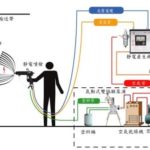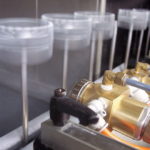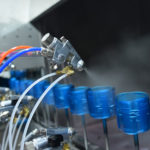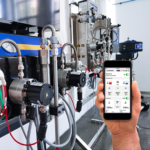
The ways of coating vary a lot from different industries, here we make a brief introductionto some popular solutions such as spraying, wiping, brushing, blade coating, roller coating and robotic coating etc. Let’s take a look at their respective characteristics!
Spray coating
Spraying is a method of atomizing liquid coating then spray onto the product. Due to different atomization principles, it is divided into air based spraying, airless spraying, electrostatic spraying, robotic spraying etc.
1- manual spraying
It is suitable for flat piece coating such as furniture, it needs to be combined with paint mixing and conveying equipment.
2- machine automatic spraying
Suitable for most products mass painting requirements for high quality, combined with automatic paint pump and conveyor system.
3- electrostatic spraying
It is suitable for complex shaped products coating especially small-sized parts. It is mainly on UV, NC, PU and W paint, it is an efficient and paint saving solution.
Wiping
Wiping is mainly used for the construction of wood surface coating or wood wax oil. Generally, the tool is a material having good oil absorption such as cloth to mix with a certain amount of paint then evenly coated on wood surface for filling, sealing and coloring purpose.
At present, it is generally used in coloring processes such as filling agent, Grice, base sealing and coloring process.
Features:
- It is carried out in three ways: circle coating, cross coating and direct coating;
- Simple & easy to operate paint saving;
Procedure:
Make a wiping tool.
Use clean cloth to tie to a ball shaped about 3-5cm;
2) Pick up the paint.
Use the prepared wiping tool to pick up the paint, and then apply the coating in the forward/counterclockwise direction on board surface. When applying the ring, press down a little to apply the whole board surface;
3) Fill the pipe hole.
Wipe heavily with clean cloth in the direction of the grain, and fill the hole in the wood as much as possible. In this process, the shade of the color should be checked against the depth of the swatch to preserve or clean the color;
4) Wipe excess paint.
Finally, use a clean wiping tool to wipe the excess coating on board surface in the direction of wood grain so that no floating powder accumulates and the color is uniform;
Notes:
1) About solvent
Since the coloring process is accompanied by wiping, due to the color difference of wood, we generally prepare two solutions to be used;
2) About the filler
When filling is the main purpose, the filler should not be too thick, otherwise it is difficult to operate; it should not be too thin, otherwise the hole filling property is poor;
3) About wiping
A clean cloth head must be used for wiping. The cloth must not be reused from the previous stage. The last wiping process must be done before it is dried, otherwise it will not be cleaned; it must be in the direction of wood grain, otherwise it will leave a wipe mark on the surface.
Dip-in coating
Dip-in coating is to complete immerse object in a container with paint, after a short period of time, it is taken out of the tank and the excess coating liquid is recirculated back into tank.
Features:
- Paint saving, time and labor saving;
- The coating film flatness is poor, suitable for primer construction;
- It is suitable for small but complex shape objects such as toys
Notes:
1) Scope of application
Flat or small objects with sharp corners are not suitable for dip coating;
2) Construction suggestions
- the optimum temperature for dip coating is 15-30 ° C;
- Dip-in coating is recommended to use low viscosity, non-volatile coatings, generally not suitable for NC coating. If a thicker coating is required, PU primer is suggested;
- The container for coating should be solvent resistant substrate;
Brushing
Features:
- Paint saving, time-consuming and labor-intensive;
- The coating film flatness is poor, suitable for primer construction;
- Normarlly used together with wiping;
Operation recommendations:
- When brushing, it should follow the principle of difficult first, frequent paint drawn and less brushing.
- When brushing, the speed should keep the same, and the force should be evenly balanced, so as to ensure uniformity of paint film;
- The number of round trips during brushing should not be too much, otherwise bubbles may be generated to make the paint film rough or have brush marks;
- Do not draw too much paint when applying vertical brushing, and the brushing speed should be faster to prevent sagging;
- After brushing, the paint brush should be washed immediately with thinner, immersed in solvent or hung in a ventilated place to dry;
Scraping
Features:
1) Mainly used for scraping putty and water ash for hardware pretreatment;
2) Paint saving, time-consuming and labor-consuming;
Operational recommendations:
- The putty or filler to be formulated should be soft and suitable. If it is too dry, it will not scratch, and the hole-filling agent will not be easily filled into the wooden eye, causing uneven coating; if it is too thin, it will not be filled due to fluidity, and it is quite troublesome to operate;
- Operator needs to be well trained in order to use scraper;
- Make good operation rules, keep the surface clean, and not waste filler material;
Roll coating
Applicable to standard flat type furniture surface coating based on UV, NC. An efficient, fast, paint and labor saving solution.
Generally, spraying is a more efficient way, with high efficiency and better quality than most other solutions. There are many ways to spray, including manual air spraying, automatic air spraying, airless (high pressure) spraying, aeration (auxiliary air) spraying, electrostatic spraying etc.




